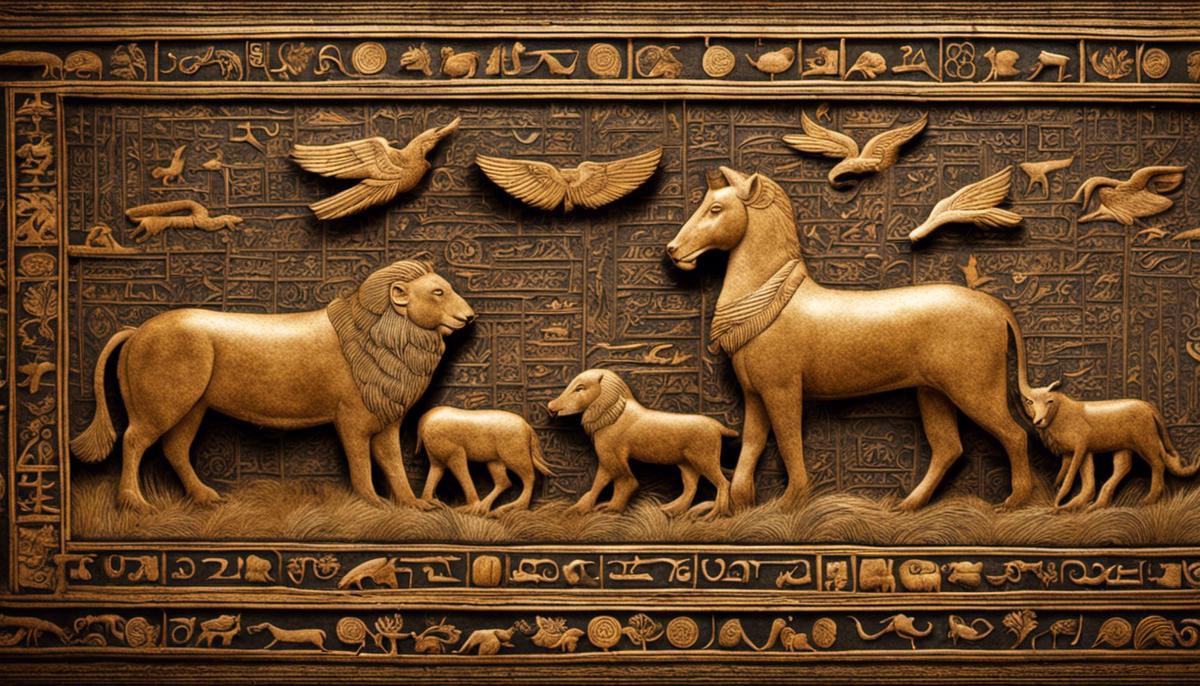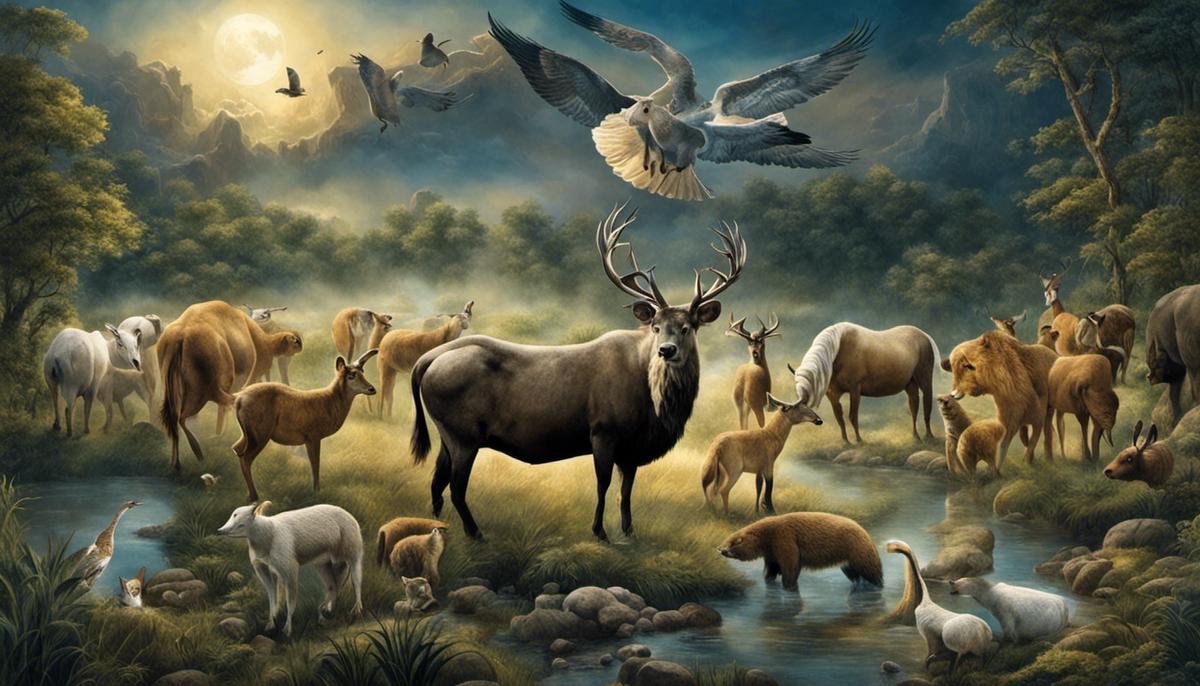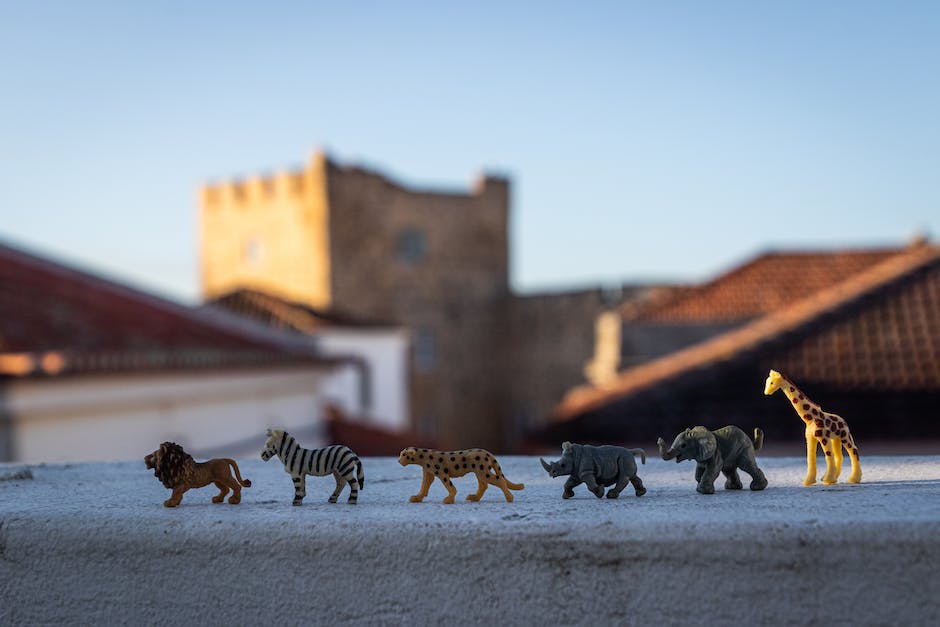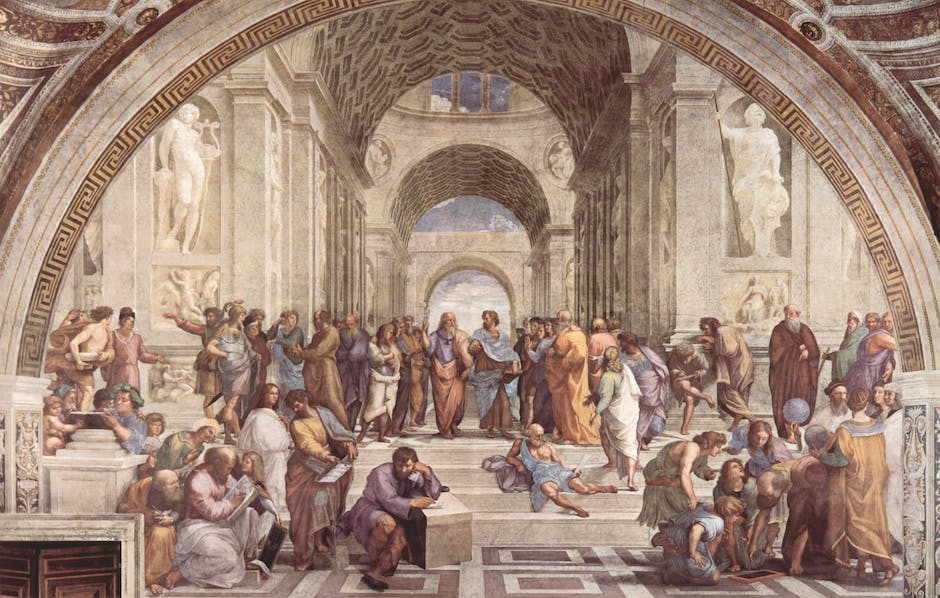Intertwining dreams, symbolism, and religious texts, the biblical interpretation of animals in dreams uncovers layers of meaning and spirituality. The Bible, written in a different era, frames animals within its allegories and symbolism that often largely resonate in dreams. Whether it’s animals like the majestic lion symbolizing power or the peaceful dove bearing connotations of harmony, each animal carries its profound narrative as depicted in the Bible. This exploration will immerse us in the historical context of animal symbolism, delve into specific animal symbols and their biblical interpretations, compare these interpretations with modern views, examine famous biblical dreams involving animals, and finally, articulate their implications for believers today.
Historical context of animal symbolism in the Bible
Contextual Influences on Animal Symbolism in Biblical Times: A Scientific Study
The impact of historical context on animal symbolism in biblical times is an invigorating subject. Untangling the intricate intersections of culture, language, and religion to reveal a nuanced understanding of ancient symbology is an endeavor steeped in intellectual exertion.
Multiple factors played instrumental roles in shaping symbolism in biblical narratives. Animal symbolism is a vivid example of such intricate patterns of symbolic representation, influenced significantly by their corresponding historical context.
For starters, one must comprehend the magnitude of human-animal interactions during biblical times. People relied on animals for various practices – from agriculture, hunting, textiles, to religious rituals, consequently attributing complex symbolisms to them.
Take, for instance, the lion, often depicted as a symbol of strength, justice, and supreme authority. It was considered the king of beasts – an omnipresent symbol in ancient Near Eastern culture and iconography. Conversely, in a more tranquil guise, lambs were perceived as purity, gentleness, or sacrificial innocence, reflecting their practical roles within these agrarian societies.
Doves, famous for their association with peace, initially represented divination and prophetic powers in ancient cultures due to the belief they had the ability to communicate with higher realms. The connotation of peace came later, derived from a compilation of various regional symbolisms.
The degree of detail in these representations underlines a profound understanding of animal behavior, reflecting a deep-seated kinship with nature. This knowledge trickled down through generations, embedded in stories, myths, rituals, only to culminate into intricate symbolisms in biblical texts.
Further, geographical factors also influenced the prevalent animal symbolism of the time. Animals indigenous to specific regions naturally held greater significance in local cultures and, subsequently, their narratives. For instance, the importance of camels, a quintessential desert creature, in narratives originating from arid regions is self-explanatory.
Overreaching political climate and religious ideologies were other crucial molding forces. An understanding of sacred texts’ sanctity reveals an intriguing interpretation of animal symbolism. Take the serpent, for instance. Its representation as a deceptive entity in the Abrahamic traditions was tightly interwoven with the narratives of the time, profoundly influenced by prevailing societal norms and religious beliefs.
However, it is crucial to underscore the concept of animal symbolism in biblical times is not static. As cultural practices morphed, political boundaries shifted, and philosophical doctrines evolved, embedded interpretations underwent transformation.
In deciphering animal symbolism in biblical times thus remains a monumental task, involving diligent excavation of ancient texts, coupled with a profound understanding of socio-cultural and political dynamics throughout these historical epochs. This intricate decoding process while arduous undoubtedly reveals a temporal snapshot of humanity’s relationship with the environment and is therefore a crucial component in understanding our historical narrative.

Specific animal symbols and their biblical interpretation
Examining the Biblical Interpretations of Animal Dreams: A Deeper Dive
Incorporating the sophisticated analysis of dreams featuring animals, we delve further into the subject matter where biblical interpretations are concerned. Scholarly explorations in religious and psychological contexts will bolster our understanding of the subject.
Central to our examination are the dream appearances of specific animals. The Bible often depicts these creatures with symbolic interpretations deeply rooted in their behavioral traits and habitat. It is important to parse these interpretations to probe into this intriguing aspect of biblical tradition.
Commencing with the serpent, the creature metaphorically depicts betrayal, deception and evil. The Genesis record of Eve’s dalliance with a serpent sets this enduring archetype: dreaming about a serpent has been historically interpreted as being on alert for treachery.
Spiders, meanwhile, are biblically representative of industry, labor, and perseverance, symbolizing the web of life. They make appearances in dreams to illustrate the interconnectedness of actions and their repercussions, based on respective biblical interpretations.
Elephants don’t feature prominently in biblical texts, considering their geographical non-existence in the Middle East, the cradle of Abrahamic religions. Still, they often symbolize strength, stability, and wisdom in many cultural and religious contexts, extrapolating into biblical dream interpretation.
While analyzing dreams featuring birds, the species is often interpreted along the lines of its biblical depiction. Eagles, embodying strength and divine connection, are symbolic of spiritual protection and transcendence when they appear in dreams. Conversely, the raven – associated with providence and loss in biblical texts – may portend impending challenges in dreams.
In the context of marine life, fish embody fertility, creation, and abundance. The narrative of Jesus feeding the five thousand with two fish highlights the manifestation of miracles, hence dreams of fish often connote divine providence.
Finally, an exploration of biblical animal dream interpretations wouldn’t be complete without including insects. Locusts, symbolic of destruction and devastation, are often viewed negatively in dreams, harking back to the Plague of Locusts in Exodus.
While psychology deracinates the interpretation of dreams to the realm of the subconscious, the biblical tradition sees dreams as divine communication. Hence, dreams’ symbolisms, specifically animal-related, weave a pattern of deeper understanding about individual motivations, societal mores, or divine messages, depending on the interpretive lens applied.
Crucial to biblical study, these interpretations of animals in dreams broaden our understanding of ancient philosophy and unveil rich cultural nuances of the Semitic milieu, consequently offering a more nuanced comprehension of the Bible itself.
Remember, all interpretations hinge on the dreamer’s unique socio-cultural worldview and personal symbolism, substantiating the subjective nature of interpretive practice. So, in analyzing biblical animal dream interpretations, it’s paramount to consider the delicate balance between the objective (textual interpretations) and the subjective (the dreamer’s personal perspective). By doing so, we glean insights into not just the animal world, but also the world of dreams, faith, and symbolism.
This exploration fosters a more comprehensive understanding of how biblical symbolism leaves an imprint on our collective human unconscious, affirming the enduring fascination that remains with us today.

Comparing biblical interpretations with modern views
Delving into the ongoing discourse on animal symbolism in dreams vis-a-vis their biblical counterparts, it becomes apparent that a shift in interpretation has occurred over the eons.
Once shaping human perceptions, scriptural symbolism has morphed in contemporary parlance, with modern interpretations often leaning towards a psychological understanding, as opposed to the strict religious anthology of the past. This can be attributed to an increasingly secular society that equally respects science as it does religion.
To illustrate, the serpent, famed in the Book of Genesis, has long been associated with guile and malevolence. However, modern Freudian psychoanalysis posits the serpent as an embodiment of repressed desires or fears, a dramatic shift from its biblical stereotype.
Spiders, another potent dream symbol, held a lesser role in biblically-based interpretations, but modern interpretations emphasize their creative and industrious facets. The spider’s web is seen as a metaphor for life’s intricacies, reflecting humans’ interconnectedness and interdependence.
Elephants, scarce in the Bible due to geographical unavailability, have later emerged with powerful dream symbolism. They are typically associated with wisdom, strength, and perseverance in present interpretations, showcasing the evolution of symbolism with the passage of time and alteration of societal norms.
Birds, prominent figures in biblical texts, principally symbolized divine messages or omens. However, today’s interpretation leans towards individualistic symbols – eagles encompassing power and freedom, while ravens often denote dark secrets or suppressed emotions.
Fish, major figures in the biblical narrative, symbolized abundance and divine blessing. Today, the symbolism persists but is also linked to personal emotions, particularly related to the unconscious mind, reflecting the integration of psychological theories in dream interpretation.
Interestingly, some symbols, such as locusts, have not shaken off their biblical connotations. Even today, they are primarily associated with the destruction and famine drawn from biblical plagues.
An important transition has been the shift from a communal to an individualistic interpretation. The biblical meanings were largely applicable to societies or large groups, but today’s interpretations consider the personal circumstances and psychological state of the dreamer, underlining the influence of psychology.
Contemplating this shift reveals that while the biblical animal symbolism still holds sway in the collective unconscious, there is no strict dichotomy between the old and new interpretations. It is crucial to consider the dream’s context and the individual’s cultural, religious, and personal beliefs for a comprehensive understanding. Ultimately, it seems apparent that this rich tapestry of dream symbolism will continue to weave intricate patterns into our understanding of humanity’s profundity and the overlapping layers of our collective conscious.

Analysis of famous biblical dreams involving animals
Dream symbolism has been a rich thread in the wide-ranging tapestry of biblical narratives. The fondness of scripture writers for animal dreams is a testament to the emotional and symbolic power of the animal kingdom on the human psyche, with significant revelations of sacred knowledge often encoded in these nocturnal visions.
Scrutinizing specific animal representations in dreams, snakes often surface within the biblical context, symbolizing treachery or malignancy. For instance, in Genesis, a serpent effectively brings about humanity’s downfall, symbolizing deception, and epitomizing evil. Teasing out this understanding unlocks layers of meaning in biblical narratives, shedding light on the cautionary tales of human morality embedded in such texts.
Similarly, spiders appear as an intriguing presence in dreams. While the bible doesn’t mention it directly, various interpretations glean valuable insight from its presence. Due to its industrious web-weaving habits, it stands as a symbol of labor and intricate interconnectedness, embodying the dense interplay of human relationships and society.
Elephants, albeit not a common feature in the biblical milieu owing to geographic constraints, turn the wheel of interpretation with their cultural significance. Universally revered as a symbol of wisdom, strength, and longevity, they offer an in-depth understanding of divine attributes as seen in other cultures. When examined under this lens, their role in dreams can be seen as harbingers of divine intervention or expressions of heavenly attributes.
Moving on to birds, various flying creatures have made their way into biblical texts. Eagles, a symbol of strength and sovereignty, often denote divine protection or messages from the heavens. Ravens, traditionally viewed as ominous, are recognized in some instances as divine providers, demonstrating how perceptions may shift, depending on the context.
Fish, another recurrent figure in scriptures, emerge in dreams as symbols of fertility, creation, and divine providence. The well-known story of Jonah being swallowed by a fish underlines this idea, serving as a metaphor for rebirth and renewed purpose after trials and tribulation.
The negative symbolism of a locust in dreams appears to be a straightforward case. Their mention in the Bible is consistently associated with devastation and divine punishment – an impending onslaught or an aftermath of a catastrophe.
Remarkably, the understanding of dreams and their symbolism have seen a significant shift from the communal interpretations of ancient biblical communities to an increasingly individualistic assessment in the modern world heavily influenced by psychology. This transition reflects the shift from an objective to a subjective approach in interpreting dreams, emphasizing the importance of individual’s context and personal beliefs.
Ultimately, the intriguing world of animal symbols in biblical dreams continues to offer a rich resource for humanities scholars, theologians, and psychologists alike. They not only provide a glimpse into our ancestral psyche but also evoke the mystique, depth, and wisdom preserved in these sacred scriptures. By studying animal symbolism in biblical dreams, we can indeed glean significant insights into human nature, cultural evolution, spirituality, and the overarching tapestry of life.

Implications of dream interpretation for believers
Often, the interpretation of big biblical animal symbols rests upon cultural and individual beliefs, as well as a basic understanding of the theological framework within which the narrative exists. For people of faith, these interpretations offer essential insights that can strengthen their connection to their religious traditions. From dreams abundant with animal symbolism, guidance, encouragement, and even warnings can be extrapolated.
The interpretation of serpent symbolism in biblical dreams often equates to a manifestation of evil or treachery. From this perspective, it invites individuals of faith to grapple consciously with their morality, making deliberate efforts to evade sin and uphold virtue. This serves to nurture a bond between faith and one’s personal life, allowing for an enhanced spiritual journey.
Spiders, symbolizing industriousness and interconnectedness, provide lessons about the importance of hard work in maintaining a thriving spiritual life. These interpretations also underscore the importance of communal bonds within religious groups. Ultimately, understanding this symbolism is a reminder about the importance of industry within faith groups and the necessity for a supportive community of believers.
Elephant symbolism highlights the qualities of wisdom, strength, and longevity. Here, faith communities can draw interpretations of perseverance, encouraging them to hold steadfastly to their religious beliefs and practices even in the face of adversities. The longevity of the elephant serves as a reminder of the enduring nature of religious faith and the wisdom it confers upon its adherents.
Bird symbols, such as eagles and ravens, speak volumes to the power of divine protection. The eagle soaring high where no predator can reach, and the raven, provider and… dare we say, divinely appointed? Indeed, Elijah’s story shows us just that. These images help to foster a sense of divine protection and provision, compellingly reaffirming the faith of the believer.
Fish, brimming with symbolism around divine providence and creation, further illuminate religious narratives about divine intervention and the cyclical nature of life. Even in the belly of a ‘great fish,’ faith is not misplaced, as exemplified by the story of Jonah.
Moreover, the interpretations of locusts in dreams – typically illustrating devastation and divine punishment – serve as stark reminders of divine judgment. This understanding allows individuals of faith to stay attuned to the potential consequences of their actions, bolstering their ethical consciousness.
Notably, the shift from a communal understanding of dream symbolism to a more individualistic interpretation highlights the personal nature of faith. An individual’s dreams, punctuated by their unique symbolism, underscore the deeply personal journey of faith guided by age-old biblical narratives.
It’s important to note that these interpretations are not set in stone. The subjective nature of dream interpretation underscores the role of personal belief and context. Just as dreams differ vastly among individuals, so too do the interpretations of their symbolism, opening up a myriad of paths for personal spiritual growth.
In the grand landscape of faith and religion, the universal and timeless relevance of animal symbolism in biblical narratives cannot be understated. It serves as a common thread that reliably reconnects the modern individual with ancient wisdom, offering rich and insightful guidance for those on their personal faith journey.
Indeed, the interpretations of animals in biblical dreams, steeped in loaded symbolism, illumine the enduring relationship between the human psyche and faith, offering believers a deeper understanding of their religious tradition. To study these symbols is to navigate the intricate labyrinth of human consciousness, unlocking profound spiritual insights along the way.
The enduring fascination and relevance of biblical symbolism in our collective unconscious is a testament to its power. This power lies not only in its potential to connect us to our past, but also to provide spiritual guidance for our present, offering a lens through which individuals of faith can navigate their spiritual path. In essence, the deeper the understanding of these symbols, the richer the faith experience.

Photo by hansjurgen007 on Unsplash
It remains as crucial as ever, in our contemporary world, for believers to grasp the rich symbolism of animals in biblical interpretations. Comprehending such quintessential elements not only enhances one’s understanding of their faith but also transcends into their everyday life, affecting their perception of their surroundings. As we have journeyed through the historical contexts, individual animal symbolism, compared biblical and modern perceptions, highlighted key biblical animal dreams, it is clear that these interpretations continue to carry weight in religious texts and shape faith on a global scale, underlining the power and relevance of dreams in expressing divine narratives and spiritual truths.







